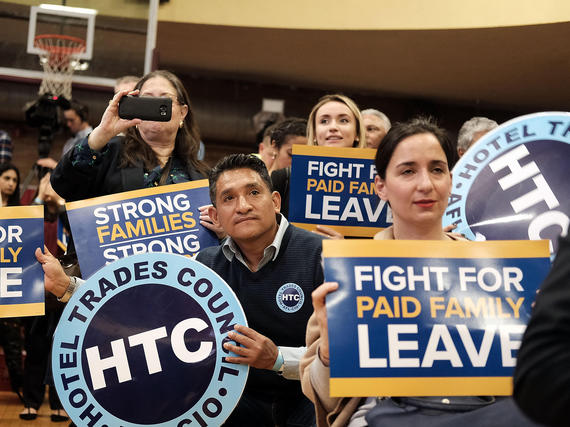Co-Authored by: Valerie Young, JD,
Outreach director for CPS's Caring Economy Campaign. Valerie's work appears extensively in social media, @WomanInDC on Twitter, Your (Wo)Man in Washington on Facebook, and blogging for Mom-mentum.org. She also has written for The Shriver Report, Brain/Child Magazine, and is frequently featured on BlogHer.com as well as the CPS and CEC blogs.
Now that the conventions are over and party platforms drawn up, we can look at what's in store for those giving and receiving care. Whether paid or not, care is a big part of our economy and shapes all our lives.
So, the question could not be more urgent. Who - or in this case, which party - cares?
Both party platforms include reference to the needs of family members caring for an ill, elderly, or disabled loved one. The number of such caregivers will surely increase as the number of Americans over age 65 will nearly double by 2050.
According to Altarum Institute, the GOP platform states "Our aging population must have access to safe and affordable care. Because most seniors desire to age at home, we will make homecare a priority in public policy and will implement programs to protect against elder abuse."
The Democratic platform expresses a similar view: "Our work and family policies must also ease the burden on family caregivers, in part by creating a strong, stable workforce to help meet families' needs. We will take steps to expand and strengthen the homecare workforce."
But are these sentiments backed up with specific proposals? Do the party platforms address the fact that a major reason elderly women in the United States are so disproportionately poor is that our nation invests less than any other developed country on supporting the care work primarily performed by women, for free, at home? Do they take into account the fact that direct care workers at best earn a minimum wage (less than dog walkers and parking lot attendants) and often have to rely on public assistance to make ends meet?
Direct care is one of the fastest growing job sectors, so there is great opportunity here to strengthen the middle class and the economy by promoting a living wage and benefits for the home care community. Better pay for this essential work would help close the persistent gender pay gap, because a majority of care providers are women.
The Democratic platform specifically pledges to support equal pay. But the Republican platform makes no mention of the gender pay gap. Nor has Donald Trump addressed the issue.
When she served as a US Senator, Hillary Clinton introduced the Paycheck Fairness Act, which would increase penalties on discriminatory employers and protect workers from retaliatory action for sharing compensation information. During the Cleveland convention, Trump's daughter, Ivanka, unexpectedly stated her father would "fight for equal pay for equal work." But the candidate has not said this.
Ms. Trump also claimed that her father would make "high quality childcare affordable and accessible for all". But Mr. Trump has not mentioned this either. Nor is it in the party platform.
The Democratic platform contains the following provision: "We will increase childcare investments to make quality childcare more affordable, boost wages for childcare workers, and support the millions of people paying for, coordinating, or providing care for aging relatives or those with disabilities."
A stark contrast also exists between the parties and candidates regarding paid maternity and paternity leave for new parents, and for all workers caring for family members - an issue of major importance for young voters starting families.
Hillary Clinton and others at the Democratic convention gave full-throated support to paid family leave. The proposed Family and Medical Leave Insurance Act, which recognizes that all parents and employed adults will experience care demands at some point and provides for 12 weeks of partially paid income replacement, is seen as a basic minimum labor standard by the Democratic party. Trump and the GOP platform make no reference to this.
We have long known that policies that support care and value those who provide it further a stronger society and shared prosperity. Using our expanded economic measures, which we call Social Wealth Economic Indicators, the link between public investment in a care infrastructure and human well-being becomes visible in terms of dollars and sense. Writing recently in The New York Times, columnist Nick Kristof stated "...the evidence is also overwhelming that when women gain power and a seat at the table, we men benefit as well."
Yet when we look at the U.S. in comparison to other nations around the world, it's clear that the US has been falling farther and farther behind in accessing the full spectrum of women's economic power, in preparing future generations to lead, and in caring for the families we have now.
These issues merit much greater attention. It is high time the pundits and the public recognize that policies that support both those who give and receive care will decrease poverty and income inequality, reduce public assistance, promote gender equality, and lead to greater family economic security and a stronger economy.
Riane Eisler, JD, is president of the Center for Partnership Studies (CPS) and author of The Real Wealth of Nations: Creating a Caring Economics.
Valerie Young, JD, is Outreach Director for CPS's Caring Economy Campaign and blogs at Your (Wo)Man in Washington

